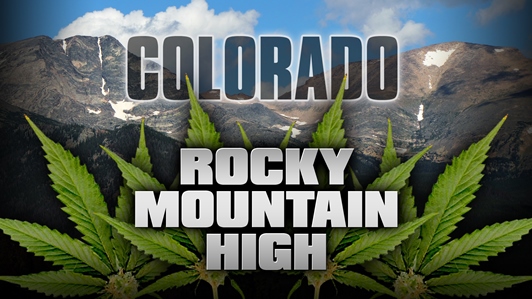Color Colorado Purple
Written by Robert Knight
The Rocky Mountain State is known for its purple mountain majesties, as immortalized in “America the Beautiful.”
But If Katharine Lee Bates, who wrote the nation’s unofficial anthem in 1913, were penning her lyrics near Pike’s Peak today, she might be humming “Purple Haze” by Jimi Hendrix.
Colorado is purple all over, from legalizing recreational use of marijuana in 2012 to its role as a crucial swing state.
From the hippie districts of Denver and Boulder to the Christian conclaves in Colorado Springs, there’s something for every persuasion.
I knew we weren’t in Kansas anymore when we pulled into a service station with a green facade and pump signs that said “Gas and Grass.” Seriously. After filling their tanks at the Native Roots station, customers can buy various brands of weed.
Big-spending politicians love this because they collect taxes on both the gas and the grass. And, it’s all “for the children.” You can make any vice respectable by promising booty for government schools. It’s how the ruling elites managed to get 44 states to hold Powerball lotteries, which fleece the working poor while reducing the incentive to downsize government.
Colorado’s pot o’ pot money is growing. In July, it netted nearly $17 million in combined marijuana taxes, up from nearly $11 million in July 2015 — a 55 percent increase. It’s almost enough to make you forget the impact on impressionable youth.
According to the 2009 National Youth Risk Behavior Survey, one in 10 “A” students had smoked pot in the past month, versus 19 percent of “B”s, 30 percent of “C”s, and 48 percent of “D”s. That was before Colorado joined Alaska, Oregon and Washington State, plus the District of Columbia, in legalizing it.
Not to worry. In a November 2015 referendum, Coloradans voted to use $40 million of the pot for school construction, with $2.5 million more for drug education, which is supposed to undo some of the damage to the kids.
Driving around north-central Colorado, we saw no political bumper stickers, but a few Gadsden flags prominently displayed. The local paper in Steamboat Springs runs columns by liberals and conservatives. We got the feeling that outside the Denver area, the state was mostly conservative, and in some cases, aggressively so.
The Steamboat Institute, a conservative think tank in Steamboat Springs, conferred its Courage in Education Award to University of Colorado President Bruce D. Benson this past weekend for his politically incorrect stewardship — he actually believes in freedom of speech and has moved to protect it on his four campuses.
Meanwhile, leftist billionaires like Colorado’s own Tim Gill are intent on turning Colorado blue. Democrats hold a three-seat House margin, while Senate Republicans have a one-seat majority. If Democrats hold the House and pick off one senator, they’ll restore one-party government under Gov. John Hickenlooper, who is not up for re-election until 2018. On the other hand, the Republicans could take both houses and give Hickenlooper a major headache.
Five Democrats — two House candidates and three for Senate — have received small donations from leftist billionaires George Soros and California environmentalist Tom Steyer, the latter of whom has become a major player in Colorado.
Writing in CompleteColorado.com, Simon Lomax noted that, “One of the state’s top political analysts — Floyd Ciruli — has already called Mr. Steyer’s spending on Colorado research and polling this election cycle ‘extraordinary.’ The California billionaire — a huge backer of anti-fossil fuel groups — is looking for ‘vertical control of the ballot, taking over the state for his environmental agenda,’ Mr. Ciruli said. Mr. Steyer has spent $943,000, so far on the “Greenprint,” an updated version of the “Blueprint” executed by heavily-funded liberal groups that flipped the governorship, congressional and U.S. Senate seats and the state House chamber to the Democrats over the last decade.
Four initiatives are on the November ballot — ColoradoCare (“universal health care”); a minimum wage of $12 an hour by 2020, and a “right to die” amendment allowing terminally ill adults to take prescribed poison.
Not all Coloradans are thrilled with seismic cultural changes via referenda, however.
Also on the ballot is Amendment 71, which would make it harder to amend the state Constitution, requiring a 55 percent vote instead of a simple majority and making it harder to even get on the ballot. Perhaps its supporters fear a future in which more of the voting population is stoned and will vote for things like massive, tax-funded “munchies” subsidies.
It doesn’t take a genius to figure out why progressives are keen on blowing the purple haze far and wide.
This article was originally posted at the WashingtonTimes.com













